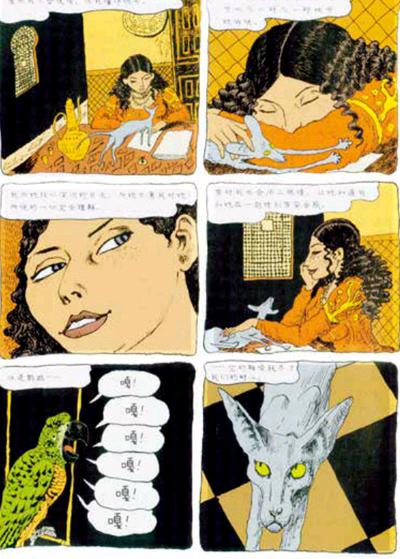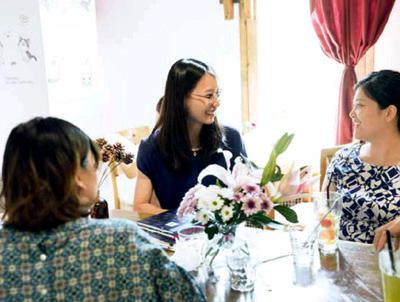The Plural Meaning of Happiness: Graphic Novel The Rabbi’s Cat and Translator Zhang Yi
2018-03-08byLiXia
by+Li+Xia
After a rabbis cat swallows the talkative family parrot whole, the cat miraculously begins speaking like a human.
The graphic novel The Rabbis Cat by Joann Sfar begins in Algeria during the 1920s. At that time, as a French colony, Algeria developed into an impressively diverse intersection of Jewish, Arab and French cultures.
In the novel, a widowed rabbi named Sfar, with the same family name as the author, lives with his beautiful daughter Zlabya and the cat. Representative of wisdom in Judaism, a rabbi teaches the Torah to the local congregation after receiving orthodox Jewish education which covered secular law as well as holy scriptures. In the novel, the rabbi is respected in his community and observes Jewish doctrines rigorously. Zlabya doesnt go out often. She takes good care of the cat, and in turn the cat considers the girl the source of its happiness. The small family lives a quiet life.
A Talking Cat
Everything changes when the cat begins to talk.
Zlabya immediately suspects that the talking cat will say unbelievable things, and she is right: The cats first words are a lie. It tells the rabbi that the parrot went out on urgent business and that the family shouldnt delay dinner on its behalf. Upon discovering the truth, the rabbi gets angry and warns the cat that languages should be used to tell the truth. However, the cat rebuts that any living being with the ability to speak can speak anything at their will, even falsehoods.
The cat incessantly tells unnecessary lies and speaks the truth only when it hurts people. It claims that compared to God, his beloved mistress is far more real. It ridicules the rabbis mentor, declaring that his faith in God is only an illusion created to reassure himself. It mocks his owners respect for the elder rabbi, asserting that he only wants someone to consult in his old age. The big-mouthed cat hopes to see how the world changes thanks to its speaking out so much “truth.”
Along with the ability to talk, the cat obtains human consciousness and begins to be plagued by the same worries as humans do. Zhang Yi, translator of the Chinese version of the novel, explains this change. She believes that precisely because of the development of language, humans began identifying the passage of time. Only through spoken language can physical time be expressed through the usage of “present”tense. And only with the existence of the present can the past and future be comprehended. Because of the connection between language and time, the disillusioned talking cat loses its faith. Even though the human lifespan is six times longer than that of cats, the cat fears that its beloved Zlabya will eventually abandon the pet to wed and have her own kids. Because of this rationale, in the cats eyes, Zlabya falls from the goddess status to become just a normal human. Its opinion of Zlabya further deteriorates to the point of considering her an illusion, which upsets and depresses the cat greatly.endprint
With its ability to understand human language, the talking cat gains the ability to search for knowledge, explore human nature and make rational judgments towards faith, which gifts it with understanding and newfound respect for life. With the ability to learn knowledge and wisdom, as well as engage in philosophical thinking, the cat ultimately finds a new happiness that transcends ordinary life.
The Rabbis Two Worlds
Thanks to his decades of work and study, the rabbi wields wisdom and lives a life grounded in honesty, sincerity and kindness, while observing Jewish doctrines explicitly. He informs the cat that Western thought is a draining, predatory and destructive machine. He declares that the Western worlds desire to solve every problem on Earth with a single stroke is just a trap. Meanwhile, the rabbi must pass a French language examination sanctioned by the French board of Jewish education to become a senior rabbi.
Zlabya falls in love with a dashing young French rabbi from Paris and they make plans to get married. The cat and the rabbi accompany the couple to France to meet the young mans family. Author Joann Sfar named this part of story The Exodus. The rabbi becomes particularly depressed in Paris: Prayer books in synagogues are all locked up, so they wont be stolen. People pray too quietly and solemnly, contrasting with the liveliness and Sabbath singing he enjoyed in Algiers. On a Sabbath, the young French rabbi rings a doorbell, which is forbidden on the Sabbath in orthodox Judaism. The rabbi encounters a Jew who eats pork frequently, smokes on the Sabbath and never prays. Even more depressing to the rabbi is the fact that such laissezfaire Jews seem to live as happily as he did back home. The rabbi ultimately posits that if people can be happy without observing the commandments, there must be no point in following so many rules that complicate life. This is also a key dilemma for Joann Sfar, as the author explores the role of religion in the modern society with warmth, wisdom and humor.
The Exodus section clearly parallels Jewish history as well as the dynamic between Algeria and its colonizer, France. By taking the French language examination, the rabbi witnesses and experiences challenges facing the Judaism in modern Parisian society. Zlabyas uneasiness in modern France illustrates the conflict between traditional society and modern civilization. The varied pursuits of happiness by people from different cultures and faiths are exhibited through the intertwining stories.endprint
Cultural Diversity: A Natural Setting for Powerful Tales
The setting of the graphic novel is not limited to Algiers. It takes readers to other parts of North Africa, Egypt, on a boat across the Red Sea to Paris and finally on a journey to Jerusalem. In each locale, the talking cat, the rabbi and his daughter encounter many other interesting characters.
Transitions of space, collisions of diverse cultures and clashes between ideas are the soil and atmosphere filling out the world created by Joann Sfar, just as they flavored the authors childhood. Before he became a comics artist, Sfar majored in philosophy at Nice Sophia Antipolis University in southern France. His background in philosophy, his Jewish heritage and his identity as a French citizen of Algerian origin gifted him with the ability to create a work with such deep and rich messages. From the perspective of human civilization, it is such diversity that has provided the environment for the growth of universal human happiness.
By utilizing the perspective of an animal, The Rabbis Cat seamlessly injects discussions of philosophical issues into ordinary everyday stories. Kids may be drawn to the fantastic colors and lines, while adults can spot the intersection and fusion of diverse cultures. Various concepts from different civilizations, such as tradition and modernity, Jewish culture and European intellectual history, and the connections between the East and the West, are re-examined and re-defined from the cats perspective and astute philosophy. This graphic novel broadens readers vision of the world, expands perceptions of the diversity of civilizations and develops understanding on the plural meaning of happiness.
By giving a mischievous cat a human mind, Joann Sfar appeals to readers from all over the world.endprint